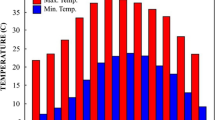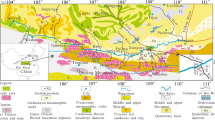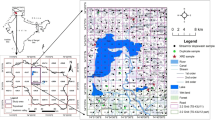Abstract
Kumtagh Desert is one of the eight biggest deserts in China, but poorly investigated before our interdisciplinary study because of the difficulty of access. In this paper, 33 representative surface sediment samples were collected from the Kumtagh Desert and analyzed in the laboratory to obtain heavy mineral components and geochemical element contents. Results show that various kinds of heavy minerals are present in these samples, with high levels of epidote and hornblende. Si and Al take up a large part of chemical composition. Compared with the average composition of geochemical elements of the upper continental crust (UCC), except Si and Ca, all elements are depleted to a certain degree; Fe, Mg, Ca, P, Ti and Mn have high correlation coefficients in their contents. The mineral and geochemical composition of the Kumtagh Desert sediments have a similarity with that of rocks of Altyn Tagh Mountains, and the surface sediments of the alluvial/diluvial fans around the Altyn Tagh Mountains and that of the Taklamakan Desert, indicating that one major source of the Kumtagh Desert sediments is located in the Altyn Tagh Mountains. Alluvial deposits and lake sediments in Aqik valley and lower reaches of Shule River are prone to be eroded and transported by the strong northeasterly wind into the Kumtagh Desert, forming another source of the desert deposits. An A-CN-K ternary diagram shows that a weak degree chemical weathering by the loss of Na and K occurred in these sediments, whereas A-CNK-FM ternary diagram suggests that Fe and Mg have undergone a significant chemical differentiation. Physical weathering processes cause easy erosion and enrichment in fine particles for mafic minerals, thus coarse desert sand particles can be relatively depleted in Fe and Mg. The mineral and geochemical composition of sediments in arid regions experiencing less chemical weathering are mostly affected by physical weathering.
Similar content being viewed by others
References
Blatt H, Middleton G, Murray R, 1980. Origin of Sedimentary Rocks. Prentice-Hall, Inc.
Chen G Y, Dai X R, Zhang M J, 1995. Study on the heavy minerals in the dustfall of the severe duststorm numbered 930505 in Lanzhou area, Gansu Province. Journal of Desert Research, 15(4): 374–377. (in Chinese)
Chen J, An Z S, Liu L W et al., 2001. Variations in chemical compositions of the eolian dust in Chinese Loess Plateau over the past 2.5Ma and chemical weathering in the Asian inland. Science in China (Series D), 31(2): 136–145.
Chen J, Ji J F, Chou G et al., 1997. Geochemistry of the chemical weathering intensity of the loess profile in Luochuan, Shaanxi Province. Science in China (Series D), 27(6):531–536.
Chen J, Li G J, Yang J D et al., 2007. Nd and Sr isotopic characteristics of Chinese deserts: Implications for the provenances of Asian dust. Geochimica et Cosmochimica Acta, 71(15): 3904–3914.
Chen Y, Chen J, Liu L W, 2001. Chemical composition and characterization of chemical weathering of late Tertiary red clay in Xifeng, Gansu Province. Journal of Geomechanics, 7(2): 167–175. (in Chinese)
Ding Z L, Sun J M, Yang S L et al., 2001. Geochemistry of the Pliocene red clay formation in the Chinese Loess Plateau and implications for its origin, source provenance and paleoclimate change. Geochimica et Cosmochimica Acta, 65(6): 901–913.
Dong Z B, Qu J J, Wang X M et al., 2008. Pseudo-feathery dunes in the Kumtagh Desert. Geomorphology, 100(3/4): 328–334.
E Y H, Su Z Z, Wang J H et al., 2006. Outcome and scientific significance of integrated investigation in Kumtag Desert. Journal of Desert Research, 26(5): 693–697. (in Chinese)
E Y H, Wang J H, Yan P et al., 2008. Evolution of palaeo-drainage system and its relationship with the formation of desert landform in the Kumtag Desert. Acta Geographica Sinica, 63(7): 725–734. (in Chinese)
He Q, Yang X H, Huo W et al., 2009. Characteristics of sand granularity from Kumtag Desert and its environmental significance. Journal of Desert Research, 29(1): 18–22. (in Chinese)
Jickells T D, An Z S, Andersen K K et al., 2005. Global iron connections between desert dust, ocean biogeochemistry, and climate. Science, 308: 67–71.
Johnsson M J, Stallard R F, Lundberg N, 1991. Controls on the composition of fluvial sands from a tropical weathering environment: Sands of the Orinoco River drainage basin, Venezuela and Colombia. Geological Society of America Bulletin, 103(12): 1622–1647.
Johnsson M J, Stallard R F, Meade R H, 1988. First-cycle quartz arenites in the Orinoco River Basin, Venezuela and Colombia. Journal of Geology, 96: 263–277.
Li X S, Han Z Y, Chen Y Y et al., 2009. Characteristics and source of rain dust in Nanjing on March 11, 2006. Quaternary Sciences, 29(1): 43–54. (in Chinese)
Li X S, Han Z Y, Yang S Y et al., 2007. Chemical weathering intensity and element migration features of the Xiashu Loess profile in Zhenjiang. Acta Geographica Sinica, 62(11): 1174–1184. (in Chinese)
Lu H Y, Wang X Y, Li L P, 2010. Aeolian sediment evidence that global cooling has driven late Cenozoic stepwise aridification in central Asia. In: Clift P D, Tada R, Zheng H (eds.). Monsoon Evolution and Tectonics-Climate Linkage in Asia. Geological Society, London, Special Publications, 342: 29–44.
Muhs D, 2004. Mineralogical maturity in dunefields of North America, Africa and Australia. Geomorphology, 59(1–4): 247–269.
Nesbitt H, Markovics G, 1997. Weathering of granodioritic crust, long-term storage of elements in weathering profiles, and petrogenesis of siliciclastic sediments. Geochimica et Cosmochimica Acta, 61(8): 1653–1670.
Nesbitt H, Young G, 1996. Petrogenesis of sediments in the absence of chemical weathering: effects of abrasion and sorting on bulk composition and mineralogy. Sedimentology, 43(2): 341–358.
Nesbitt H W, Young G M, 1982. Early Proterozoic climates and plate motions inferred from major element chemistry of lutites. Nature, 299(21): 715–717.
Ohta T, Arai H, 2007. Statistical empirical index of chemical weathering in igneous rocks: A new tool for evaluating the degree of weathering. Chemical Geology, 240(3/4): 280–297.
Qian Y B, Wu Z N, Ishii T et al., 1993. The constituent characteristics of sand materials and sand sources of Taklamakan Desert. Journal of Desert Research, 13(4): 32–38. (in Chinese)
Qian Y B, Zhou X J, Li C S et al., 2001. Multi-sources of sand minerals for the deserts in the Jungger Basin. Journal of Desert Research, 21(2): 182–187. (in Chinese)
Qu J J, Liao K T, Zu R P et al., 2007. Study on formation mechanism of feather-shaped sand ridge in Kumtag Desert. Journal of Desert Research, 27(3): 349–354. (in Chinese)
Qu J J, Zuo G C, Zhang K C et al., 2005. Relationship between the formation and evolution of the Kumtag Desert and the regional Neotectonic movement. Arid Land Geography, 28(4): 424–428. (in Chinese)
Ritts B D, Biffi U, 2000. Magnitude of post-Middle Jurassic displacement on the central Altyn Tagh fault system, Northwest China. Geological Society of American Bulletin, 112(1): 61–74.
Shi Y X, Dai X R, Li J T et al., 1995. On the wind-blown deposits from a heavy dust fall numbered “930505” in Lanzhou, North-Central China. Acta Sedimentologica Sinica, 13(3): 76–82. (in Chinese)
Stevens T, Palk C, Carter A et al., 2010. Assessing the provenance of loess and desert sediments in northern China using U-Pb dating and morphology of detrital zircons. Geological Society of America Bulletin, 122: 1331–1344.
Sun J M, Li Y, Zhang Z Q et al., 2009. Magnetostratigraphic data on the Neogene growth folding in the foreland basin of the southern Tianshan Mountains. Geology, 37, 1051–1054.
Sun J M, Liu T S, 2006. The age of the Taklimakan Desert. Science, 312: 1621.
Taylor S R, McLennan S M, 1985. The Continental Crust: Its Composition and Evolution. London: Blackwell, 277.
Turekian K K, Wedepohl K H, 1961. Distribution of the elements in major units of the earth crust. Bulletin of the Geological Society of America, 72(2): 175–192.
Újvári G, Varga A, Balogh-Brunstad Z, 2008. Origin, weathering, and geochemical composition of loess in southwestern Hungary. Quaternary Research, 69(3): 421–437.
Wang S J, 1987. Formation of Aqik valley in the east of Lop Nor. Lop Nor Comprehensive Scientific Expedition Team, Xinjiang Branch of Chinese Academy of Sciences, Lop Nor Scientific Expedition and Research. Beijing: Science Press, 60–67. (in Chinese)
Weltje G J, von Eynatten H, 2004. Quantitative provenance analysis of sediments: Review and outlook. Sedimentary Geology, 171(1–4): 1–11.
Xia X C, 1987. Basic character of Kumtag Desert. Lop Nor Comprehensive Scientific Expedition Team, Xinjiang Branch of Chinese Academy of Sciences, Lop Nor Scientific Expedition and Research. Beijing: Science Press, 52–59, 78–94. (in Chinese)
Xie J, Ding Z L, 2007. Compositions of heavy minerals in Northeastern China sandlands and provenance analysis. Science in China (Series D), 50(11): 1715–1723.
Xie Y Y, He K, Zhou J et al., 2006. Chemical characteristic of dust storm deposits in Harbin and its matter origin. Geographical Research, 25(2): 255–261. (in Chinese)
Yang X B, Zhu B Q, White P D, 2007. Provenance of aeolian sediment in the Taklamakan Desert of western China, inferred from REE and major-elemental data. Quaternary International, 175(1): 71–85.
Young G, Nesbitt H, 1998. Processes controlling the distribution of Ti and Al in weathering profiles, siliciclastic sediments and sedimentary rocks. Journal of Sedimentary Research, 68(3): 448–455.
Zhang S, Liu P, Jin C S et al., 2008. Geochemistry of the heavy dust fall on 17 April 2006 in Beijing. Marine Geology & Quaternary Geology, 28(3): 36–42. (in Chinese)
Zhang X Y, Wang Y Q, Wang D et al. Characterization and sources of regional-scale transported carbonaceous and dust aerosols from different pathways in coastal and sandy land areas of China. Journal of Geophysical Research, 2005, 110(D15): D15301.
Zhang Z Q, Sun J M, 2011. Palynological evidence for Neogene environmental change in the foreland basin of the southern Tianshan range, northwestern China. Global and Planetary Change, 75, 56–66.
Zheng H, Powell C, An Z et al., 2000. Pliocene uplift of the northern Tibetan Plateau. Geology, 28(8): 715–718.
Author information
Authors and Affiliations
Corresponding author
Additional information
Foundation: The Global Change Program of China, No.2010CB950203; China National S&T Basic Work Program, No.2006FY110800; Natural Science Foundation of China, No.40930103, 41021002
Author: Xu Zhiwei (1988–), Ph.D Candidate, specialized in the physical geography.
Corresponding author: Lu Huayu (1968–), Ph.D and Professor, specialized in Quaternary environmental change and the physical geography.
Rights and permissions
About this article
Cite this article
Xu, Z., Lu, H., Zhao, C. et al. Composition, origin and weathering process of surface sediment in Kumtagh Desert, Northwest China. J. Geogr. Sci. 21, 1062–1076 (2011). https://doi.org/10.1007/s11442-011-0900-3
Received:
Accepted:
Published:
Issue Date:
DOI: https://doi.org/10.1007/s11442-011-0900-3




